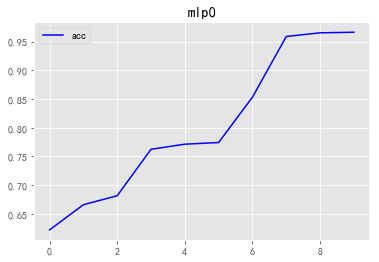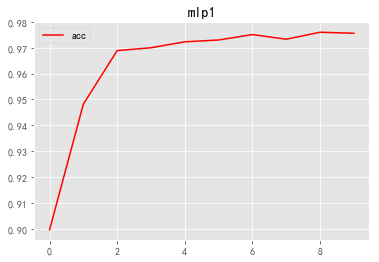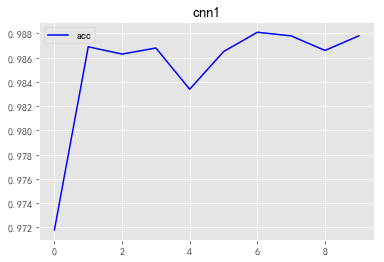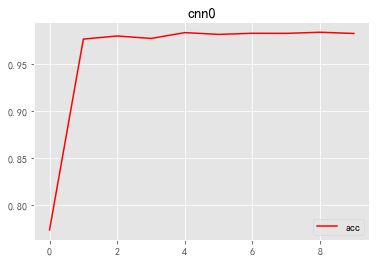1
2
3
4
5
6
7
8
9
10
11
12
13
14
15
16
17
18
19
20
21
22
23
24
25
26
27
28
29
30
31
32
33
34
35
36
37
38
39
40
41
42
43
44
45
46
47
48
49
50
51
52
53
54
55
56
57
58
59
60
61
62
63
64
65
66
67
68
69
70
71
72
73
74
75
76
77
78
79
80
81
82
83
84
85
86
87
88
89
90
91
92
93
94
95
96
97
98
99
100
101
102
103
104
105
106
107
108
109
110
111
112
113
114
115
116
117
118
119
120
121
122
123
124
125
126
127
128
129
130
131
132
133
134
135
136
|
# mnist CNN分类实例
import tensorflow as tf
import numpy as np
from tqdm import tqdm
import matplotlib.pyplot as plt
# style设置
from matplotlib import style
from IPython import display
style.use('ggplot')
np.random.seed(42)
%matplotlib inline
data = np.load("./data/mnist.npz")
x_train,y_train,x_test,y_test = data['x_train'],data['y_train'],data["x_test"],data['y_test']
# 数据规整
x_train = x_train.reshape(-1,28,28,1) / 255 - 0.5
x_test = x_test.reshape(-1,28,28,1) / 255 - 0.5
# 这个能生成一个OneHot的10维向量,作为Y_train的一行,这样Y_train就有60000行OneHot作为输出
y_train = (np.arange(10) == y_train[:, None]).astype(int) # 整理输出
y_test = (np.arange(10) == y_test[:, None]).astype(int)
batch_size = 8 # 使用MBGD算法,设定batch_size为8
# batchsize的获取
def generatebatch(X,Y,n_examples, batch_size):
for batch_i in range(n_examples // batch_size):
start = batch_i*batch_size
end = start + batch_size
batch_xs = X[start:end]
batch_ys = Y[start:end]
yield batch_xs, batch_ys # 生成每一个batch
def model_cnn_0(tf_X):
print("cnn1")
# 第一卷积层+激活层
conv_filter_w1 = tf.Variable(tf.random_normal([3, 3, 1, 10]))
conv_filter_b1 = tf.Variable(tf.random_normal([10]))
relu_feature_maps1 = tf.nn.relu(tf.nn.conv2d(tf_X, conv_filter_w1,strides=[1, 1, 1, 1], padding='SAME') + conv_filter_b1)
print(relu_feature_maps1)
# 池化层
max_pool1 = tf.nn.max_pool(relu_feature_maps1,ksize=[1,3,3,1],strides=[1,2,2,1],padding='SAME')
print(max_pool1)
# 第二卷积层
conv_filter_w2 = tf.Variable(tf.random_normal([3, 3, 10, 5]))
conv_filter_b2 = tf.Variable(tf.random_normal([5]))
conv_out2 = tf.nn.conv2d(relu_feature_maps1, conv_filter_w2,strides=[1, 2, 2, 1], padding='SAME') + conv_filter_b2
# BN归一化层+激活层
batch_mean, batch_var = tf.nn.moments(conv_out2, [0, 1, 2], keep_dims=True)
shift = tf.Variable(tf.zeros([5]))
scale = tf.Variable(tf.ones([5]))
epsilon = 1e-3
BN_out = tf.nn.batch_normalization(conv_out2, batch_mean, batch_var, shift, scale, epsilon)
relu_BN_maps2 = tf.nn.relu(BN_out)
# 池化层
max_pool2 = tf.nn.max_pool(relu_BN_maps2,ksize=[1,3,3,1],strides=[1,2,2,1],padding='SAME')
print(max_pool2)
# 将特征图进行展开
max_pool2_flat = tf.reshape(max_pool2, [-1, 7*7*5])
# 全连接层
fc_w1 = tf.Variable(tf.random_normal([7*7*5,50]))
fc_b1 = tf.Variable(tf.random_normal([50]))
fc_out1 = tf.nn.relu(tf.matmul(max_pool2_flat, fc_w1) + fc_b1)
# 输出层
out_w1 = tf.Variable(tf.random_normal([50,10]))
out_b1 = tf.Variable(tf.random_normal([10]))
pred = tf.nn.softmax(tf.matmul(fc_out1,out_w1)+out_b1)
return pred
def model_cnn_1(x):
print("cnn2")
#conv2
#layers.conv2d parameters
#inputs 输入,是一个张量
#filters 卷积核个数,也就是卷积层的厚度
#kernel_size 卷积核的尺寸
#strides: 扫描步长
#padding: 边边补0 valid不需要补0,same需要补0,为了保证输入输出的尺寸一致,补多少不需要知道
#activation: 激活函数
cn1 = tf.layers.conv2d(inputs=x,filters=10,kernel_size=(3,3),strides=1,padding="same",activation=tf.nn.relu)
print(cn1)
#tf.layers.max_pooling2d
#inputs 输入,张量必须要有四个维度
#pool_size: 过滤器的尺寸
pool1 = tf.layers.max_pooling2d(inputs=cn1,pool_size=(3,3),strides=2,padding="same")
print(pool1)
#conv2
cn2 = tf.layers.conv2d(inputs=pool1,filters=5,kernel_size=3,strides=1,padding="same",activation=tf.nn.relu)
print(cn2)
# bn归一化层
batch_mean, batch_var = tf.nn.moments(cn2, [0, 1, 2], keep_dims=True)
shift = tf.Variable(tf.zeros([5]))
scale = tf.Variable(tf.ones([5]))
epsilon = 1e-3
BN_out = tf.nn.batch_normalization(cn2, batch_mean, batch_var, shift, scale, epsilon)
relu_BN_maps2 = tf.nn.relu(BN_out)
#pool2 2*2
pool2 = tf.layers.max_pooling2d(inputs=relu_BN_maps2,pool_size=3,strides=2,padding="same")
print(pool2)
#flat(平坦化)
flat = tf.reshape(pool2,[-1,7*7*5])
dense = tf.layers.dense(inputs=flat,units=50,activation=tf.nn.relu)
#输出层,不用激活函数(本质就是一个全连接层)
out = tf.layers.dense(inputs = dense,units=10,activation=tf.nn.softmax)
return out
tf.reset_default_graph()
# 输入层
tf_X = tf.placeholder(tf.float32,[None,28,28,1])
tf_Y = tf.placeholder(tf.float32,[None,10])
# model的输出
# 第一种cnn模型
out = model_cnn_0(tf_X)
# 第二种cnn模型
# out = model_cnn_1(tf_X)
# loss
loss = -tf.reduce_mean(tf_Y*tf.log(tf.clip_by_value(out,1e-11,1.0)))
# 优化
train_step = tf.train.AdamOptimizer(1e-3).minimize(loss)
# 计算准确率
y_pred = tf.arg_max(out,1)
bool_pred = tf.equal(tf.arg_max(tf_Y,1),y_pred)
accuracy = tf.reduce_mean(tf.cast(bool_pred,tf.float32)) # 准确率
num_epochs = 100
accs = []
with tf.Session() as sess:
sess.run(tf.global_variables_initializer())
for epoch in range(num_epochs): # 迭代1000个周期
for batch_xs,batch_ys in generatebatch(x_train,y_train,y_train.shape[0],batch_size): # 每个周期进行MBGD算法
sess.run(train_step,feed_dict={tf_X:batch_xs,tf_Y:batch_ys})
if(epoch % 10 == 0):
res = sess.run(accuracy,feed_dict={tf_X:x_test,tf_Y:y_test})
accs.append(res)
print(epoch,res)
|



